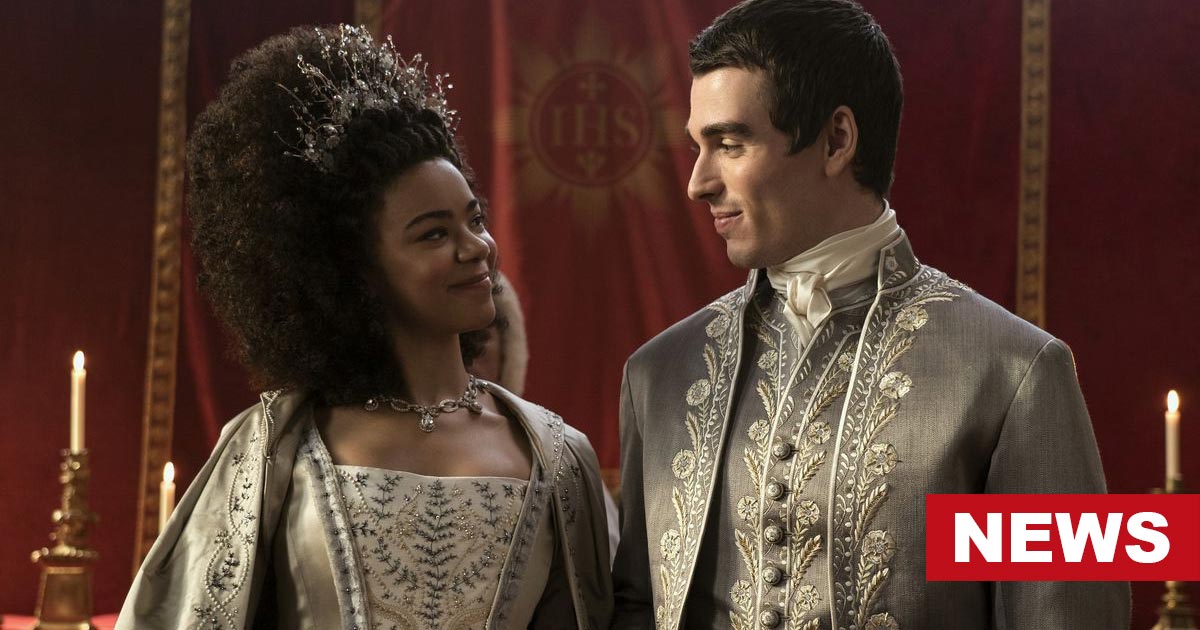When Shonda Rhimes’s Queen Charlotte: A Bridgerton Story premiered on Netflix in 2023, it debuted at number one in 91 countries, including the US, the UK, and India. The series chronicles the marriage and queenship of Charlotte of Mecklenburg-Strelitz (India Amarteifio) in 18th-century Britain.
Born in a minor German aristocratic principality, a young and fiery Charlotte was promised in marriage to the mysterious British monarch George III (Corey Mylchreest). When she is wed, she finds herself isolated in a foreign country rampant with racism and political instability.
The latter has been attributed to her husband who, in history, goes by the unflattering acronym “The Mad King Of England”. However, in a marriage plagued by mental illness and mistreatment, George and Charlotte find love and do their best to make things work.
Queen Charlotte begins in 1817 with the death of the Princess Royal Charlotte, an event that triggers a succession crisis. With the king locked away and a country under regency, the aged and lonely Queen Charlotte is seen navigating the difficult responsibilities of a helpless mother relentlessly plotting her children’s marriage with suitable partners.
Most of the series happens as a flashback and, much to the joy of the audience, shows the beginning of the Queen’s friendship with Lady Agatha Danbury (Adjoa Andoh) and Viscountess Violet Bridgerton (Ruth Gemmell)—the Bridgerton series fan favorites.
King George’s Madness: The Elephant In The Room
King George III’s mental health struggles and its implication on the stability of the British monarchy constitute a fascinating chapter in British history. Mylchreest’s King George comes across as a young and charming royal who buckles under kingship burdens.
A restrictive life, constant intrusive scrutiny, and an overwhelming load of expectations trigger frequent nervous breakdowns that pose challenges for his life and reign.
The show references the popular hint that the fictionalized King George suffers from porphyria, a rare genetic disorder that enhances risks of premature mental decline. He is also shown exhibiting symptoms related to:
- Depression
- Social Anxiety
- Avoidant behavior
- Erratic conduct
- Mood swings
- Panic attacks
- Delusion
- Mania
- Episodes of confusion
- Low self-esteem
The king’s mental health portrayal also includes the contemporary stigmatization of mental illness. The fear and apathy for mental illness is not only displayed by those around the king, but also the king himself. In shame, he shuts out his wife and keeps her in the dark about his little understood disease. But, in his desperation to be a better and happier family man for her, he avails torturous medical treatment.
Throughout the series, George III is subjected to controversial mental health treatment methods like cold water immersion, bloodletting, physical violence and restraint, and straitjackets.
The series resurfaces the infamous historical reality of the monarch’s lengthy treatment in isolation and imprisonment at Kew Palace—in the misguiding and ineffective hands of the notorious Dr. Thomas Monro of Bethlem Hospital. Going by the treatment regimes, it’s fortunate that mental health awareness and care have come a long way since then!
The Themes Revisited In Queen Charlotte: A Bridgerton Story
Much like Shonda Rhimes’ parent series Bridgerton, Queen Charlotte: A Bridgerton Story is an extremely layered piece of cinematic fiction. In a paltry runtime of six episodes, it explores themes that were not only relevant in 18th-century Britain but also the present 21st-century:
1. Racism
Queen Charlotte follows Netflix’s diversity-inclusivity-interracial love formula, except that it actually draws from 18th-century racial politics in the British Empire. When Queen Charlotte arrives in England, her mother-in-law criticizes her pronounced black features.
However, the King’s Mother Princess Augusta invites several prominent but discriminated against people of color to the royal wedding and grants them titles to show favor.
Though this is done to ‘normalize’ Queen Charlotte’s Moorish features, this stroke effectively desegregates British society and does away with regressive racial identities. As the young German Princess becomes the first royal family member of color, others follow her into prominence.
Charlotte’s rise sees Lady Danbury reinstated as a black lady-in-waiting. Under her patronage, black members of the ton are included in royal hunts and invited to society balls. In a way, the Queen and Lady Danbury in Queen Charlotte walked so that Lord Hastings could run in Bridgerton.
2. Mental Illness
As mentioned before, King George III’s madness overshadows the events of Queen Charlotte and the Bridgerton series. Through the eyes of the royal butler Reynolds, Princess Augusta, and Queen Charlotte, viewers could see the lasting effect the King’s illness had on those around him.
Events that would make any man happy like his marriage, consummation, and his wife’s pregnancy unnerve him. Even his children are impacted by his mental condition, choosing to care for their parents instead of pursuing their own lives.
The long duration of the King’s absence due to treatment and the physical separation between the royal couple denote that the Queen is left to suffer in loneliness and neglect for most of her life. As the uncanny Lady Whistledown observes in her pamphlet, “Loneliness is a battle even queens must fight”.
The audience sees the Queen harden from the adversity over time; in the Bridgerton series, a visibly old and wistful but enduring Queen Charlotte ‘dreadedly’ asks ‘carelessly’ of her husband multiple times: “Is he dead yet?”
3. Acceptance And Love
In Bridgerton: Season 1, in a conversation with Lord Hastings, the elderly Lady Danbury is seen saying: “Have you any idea [that love and affection] are precisely what have allowed a new day to begin to dawn in this society? We were two separate societies, divided by color until a king fell in love with one of us. Love, your Grace, conquers all.”
Indeed, Queen Charlotte is built on the foundation of King George III’s and his inter-racial wife’s love story. Queen Charlotte challenges her husband’s way of life and beliefs and, despite their many conflicts, he accepts her as she is.
She too overlooks the difficulties posed by his mental health conditions, unconditionally accepts his true self, and attempts to build a life with him. At one point in the series, she declares to the royal doctors: “I care not for his sanity. I care for his happiness. I care for his soul. Let him be mad is mad is what he needs.”
The celebrated ending scene of Queen Charlotte sees the Queen crawl underneath a bed with George III to prevent him from having a nervous breakdown. He calms down and the two share a moment together.
He reminds her that she did not leave before the wedding: “You did not go over the wall.” She lovingly replies: “No, George. I did not go over the wall.” Elaborating on their mutual self-acceptance and acceptance of each other, Golda Rosheuvel (who plays the elderly Queen Charlotte) said: “I love the fact that Queen Charlotte knows what to do to help King George; whereas, young Queen Charlotte is at the beginning of that journey. Queen Charlotte now knows how to communicate with the man she loves. She knows what he needs. She understands him. It’s a lifelong journey for them, and you see that in that last scene.”
4. The Difficulties Of Marriage
Queen Charlotte delves into women’s lives beyond the glittery version of high society bearings, providing insights into their challenges about marriage, childbirth, and motherhood. The very question of marriage itself is a thorny affair in the series.
The titular character herself finds that she has to contend with a mentally ill person for a husband. While Queen Charlotte experiences love, she also suffers from bouts of loneliness, instability, and ill behavior from George III. However, she never walks out of her marriage, stands by her sick husband, and helps him cope with his symptoms.
Her person butler Brimsley tells her: “You are still his queen. Forever frozen. Forever waiting.” Mylchreest (who essays young George III) said in a promotional interview for the series: “To see him [King George] like that everyday and to love him with just as much passion is incredibly painful because, in a way, you’ve lost him. Yet, Queen Charlotte can’t move on … [as her] life is dedicated to serving King George. She is frozen in time because it’s almost like he’s died, but he hasn’t. He’s still there.”
Similarly, Lady Danbury chooses to continue as the elderly Lord Danbury’s younger and unloved wife. She fights for her husband’s place in the ton and strives to look after his children after his death. Along similar lines, Dowager Viscountess Violet Bridgerton honors her late husband Edmund in her looking out for her own children and advising them on love and relationships.
5. Female Agency In A Patriarchal World
Many characters in the Bridgerton spin-off, especially the female protagonists, strive for personal agency, empowerment, and independence. An opinionated free spirit, Queen Charlotte struggles against the narrow dictates of royal life and protocol. However, she succeeds in breaking the narrow patriarchal confines and takes charge of the kingdom and her ill husband.
Even when he completely succumbs to his illness in his old years, she sustains her duty as the queen consort. Defined by responsibility, she attempts to solve the succession crisis and looks for ways to create a line of royal heirs for a vulnerable throne.
The Queen is matched in her desire for autonomy by the Dowager Princess Augusta and Lady Danbury. The King’s Mother thwarts the control imposed on her by the men at court on the grounds of her son’s illness. As a mother, she spiritedly and possessively fights for her disturbed son’s welfare, the stability of his reign, and the continuity of his bloodline.
Lady Danbury too assumes the reigns of her husband’s property and title after he passes away. Despite being pressured by the nonwhite members of the ton, she settles the matters of succession and carefully maintains her financial independence. She also takes charge of her desires and begins an affair with Lord Ledger in hope of experiencing the love she was deprived of in her loveless marriage.
Queen Charlotte: A Bridgerton Story departs considerably from the raunchy template of the preceding Bridgerton series and tackles more complex questions of race, mental health, and fragile human relationships.
It is not simply a youthful romance. It laudably travels beyond the expected to offer diverse viewpoints portrayed by each character in the story and adds depth and complexity in tackling important themes such as racism, isolation, challenging relationships, dealing with loss, and other somber topics that strongly resonate with the audience.












